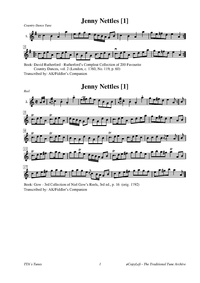Template:Pagina principale/Vetrina: Difference between revisions
No edit summary |
No edit summary |
||
| Line 1: | Line 1: | ||
{{SheetMusic | {{SheetMusic | ||
|f_track= | |f_track=Jenny Nettles.mp3 | ||
|f_pdf= | |f_pdf=Jenny Nettles.pdf | ||
|f_artwork= | |f_artwork=Lovers Knot.jpg | ||
|f_tune_name= | |f_tune_name=Jenny Nettles | ||
|f_track_title= | |f_track_title=Jenny_Nettles_(1) | ||
|f_section=abc | |f_section=abc | ||
|f_played_by=[https://soundcloud.com/ | |f_played_by=[https://soundcloud.com/user-75630746-880803498 Jonathan Taylor] | ||
|f_notes= | |f_notes= She placed her hand into her bag and pulled out the Lover’s knot. | ||
|f_caption=was the | |f_caption=Allegedly, as her fame grew through the popularity of the song, her grave was pillaged for keepsakes of the ill fated young woman. Her skull and bones were found barely beneath the surface as two gold earrings and twenty four beads were taken from her grave. The goods were taken to Edinburgh jeweller Mr Fraser of St Andrew’s street. | ||
|f_source=[https://soundcloud.com/ | |f_source=[https://soundcloud.com/user-75630746-880803498/jenny-nettles Soundcloud] | ||
|f_pix=420 | |f_pix=420 | ||
|f_picpix=200 | |f_picpix=200 | ||
|f_article=[[ | |f_article=[[Jenny_Nettles_(1) | '''Jenny Nettles''']] | ||
Jenny Nettles was a comely and fetching maiden of the village of Strathmiglo, who fell deeply in love with a Highland Officer attached to the command of the Rob Roy. The famous outlaw chief had invaded the countryside for a time but was forced to retreat to the mountains for safety, and when the clansmen marched off Jenny was deserted by her lover. In bitterness and pain from her lost love, Jenny hung herself by a roadside tree. As a suicide, Jenny Nettles could not be buried in hallowed ground, nor could a coffin be fashioned for her eternal rest. She was buried in the middle of the night in an unmarked grave. Her final resting place is at a crossroads of two forest paths on the north side of the Lomond Hills in Fife, a few minutes' walk out of Strathmiglo. Local lore has it that Jennie's ghost wanders the muir on bright moonlit nights, looking for her lost Highland love. Jenny Nettles is also a nickname for the harmless and familiar "daddy longlegs" or cellar spider, for a stinging nettle, and, on the Isle of Man, for a jellyfish. | |||
Stenhouse [1] received the following anecdote from an Edinburgh jeweler, a Mr. Fraser of St. Andrew's Street, regarding some reputed relics of Jenny's that came into his possession: | |||
Gold ear-ring and bead of a necklace which belonged to the famed Jenny Nettles of Scottish song, whom tradition mentions committed suicide, and was buried between two lairds' lands near the Lomond hills, a cairn or heap of stones being raised to mark the spot, according to ancient usage. A stranger, happening to visit a farmer in that neighbourhood, was accidentally informed of the above circumstance, and was shown the place where the cairn once stood. Prompted by the love of antiquarian research, he immediately commenced digging, when, at the depth of eighteen inches, he found the skull and other bones of poor Jenny (which must have remained inhumed at least a century), along with two ear-rings and twenty-four beads. One of the ear-rings was given to a gentleman who went to France, and twenty-three of the beads were distributed among various persons. 1830.--(C.K.S.) .... (C.K.S. are the initials of Stenhouse's contemporary, Scottish antiquarian and artist Charles Kirkpatrick Sharpe, 1781-1851). | |||
}} | }} | ||
Revision as of 06:08, 29 July 2023

Played by: Jonathan Taylor
Source: Soundcloud
Image: She placed her hand into her bag and pulled out the Lover’s knot.

Jenny Nettles was a comely and fetching maiden of the village of Strathmiglo, who fell deeply in love with a Highland Officer attached to the command of the Rob Roy. The famous outlaw chief had invaded the countryside for a time but was forced to retreat to the mountains for safety, and when the clansmen marched off Jenny was deserted by her lover. In bitterness and pain from her lost love, Jenny hung herself by a roadside tree. As a suicide, Jenny Nettles could not be buried in hallowed ground, nor could a coffin be fashioned for her eternal rest. She was buried in the middle of the night in an unmarked grave. Her final resting place is at a crossroads of two forest paths on the north side of the Lomond Hills in Fife, a few minutes' walk out of Strathmiglo. Local lore has it that Jennie's ghost wanders the muir on bright moonlit nights, looking for her lost Highland love. Jenny Nettles is also a nickname for the harmless and familiar "daddy longlegs" or cellar spider, for a stinging nettle, and, on the Isle of Man, for a jellyfish.
Stenhouse [1] received the following anecdote from an Edinburgh jeweler, a Mr. Fraser of St. Andrew's Street, regarding some reputed relics of Jenny's that came into his possession:
Gold ear-ring and bead of a necklace which belonged to the famed Jenny Nettles of Scottish song, whom tradition mentions committed suicide, and was buried between two lairds' lands near the Lomond hills, a cairn or heap of stones being raised to mark the spot, according to ancient usage. A stranger, happening to visit a farmer in that neighbourhood, was accidentally informed of the above circumstance, and was shown the place where the cairn once stood. Prompted by the love of antiquarian research, he immediately commenced digging, when, at the depth of eighteen inches, he found the skull and other bones of poor Jenny (which must have remained inhumed at least a century), along with two ear-rings and twenty-four beads. One of the ear-rings was given to a gentleman who went to France, and twenty-three of the beads were distributed among various persons. 1830.--(C.K.S.) .... (C.K.S. are the initials of Stenhouse's contemporary, Scottish antiquarian and artist Charles Kirkpatrick Sharpe, 1781-1851).
...more at: Jenny Nettles - full Score(s) and Annotations
X:2 T:Jenny Nettles [1] M:C| L:1/8 R:Reel B:Gow - 3rd Collection of Niel Gow's Reels, 3rd ed., p. 16 (orig. 1792) Z:AK/Fiddler's Companion K:Amin V:1 clef=treble name="2." [V:1] A/B/|{A/B/}c2 .B2.A2.a2|(e^f)ge dBGB|{A/B/}.c2.B2.A2.a2|ge^fd e2A:||B| Tc>deA Tc>deA|d/c/B/A/ Gd BGdB|c>deA cdea|ge^fd e2 AB| Tc>deA Tc>dec|BAGd BGdB|Tc>deA c>dec|BcdB {B}e2A||B| Tc>de^f g>age|gaTge d/c/B/A/ GB|Tc>de^f gage|aba^g Ta2 AB| cde^f gage|gage {d}cB/A/ GB|cde^f gagf|ea^gb a2A|]
